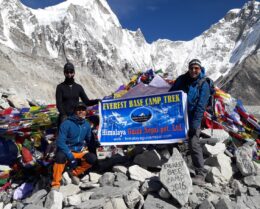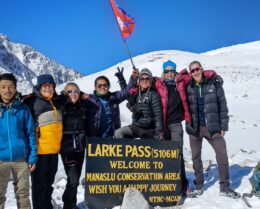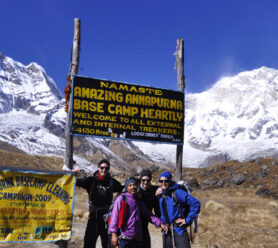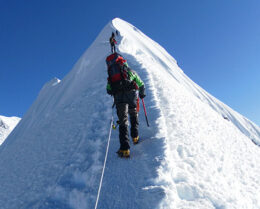Manaslu Circuit Trek Cost and Itinerary
UPDATED ON 26 March, 2024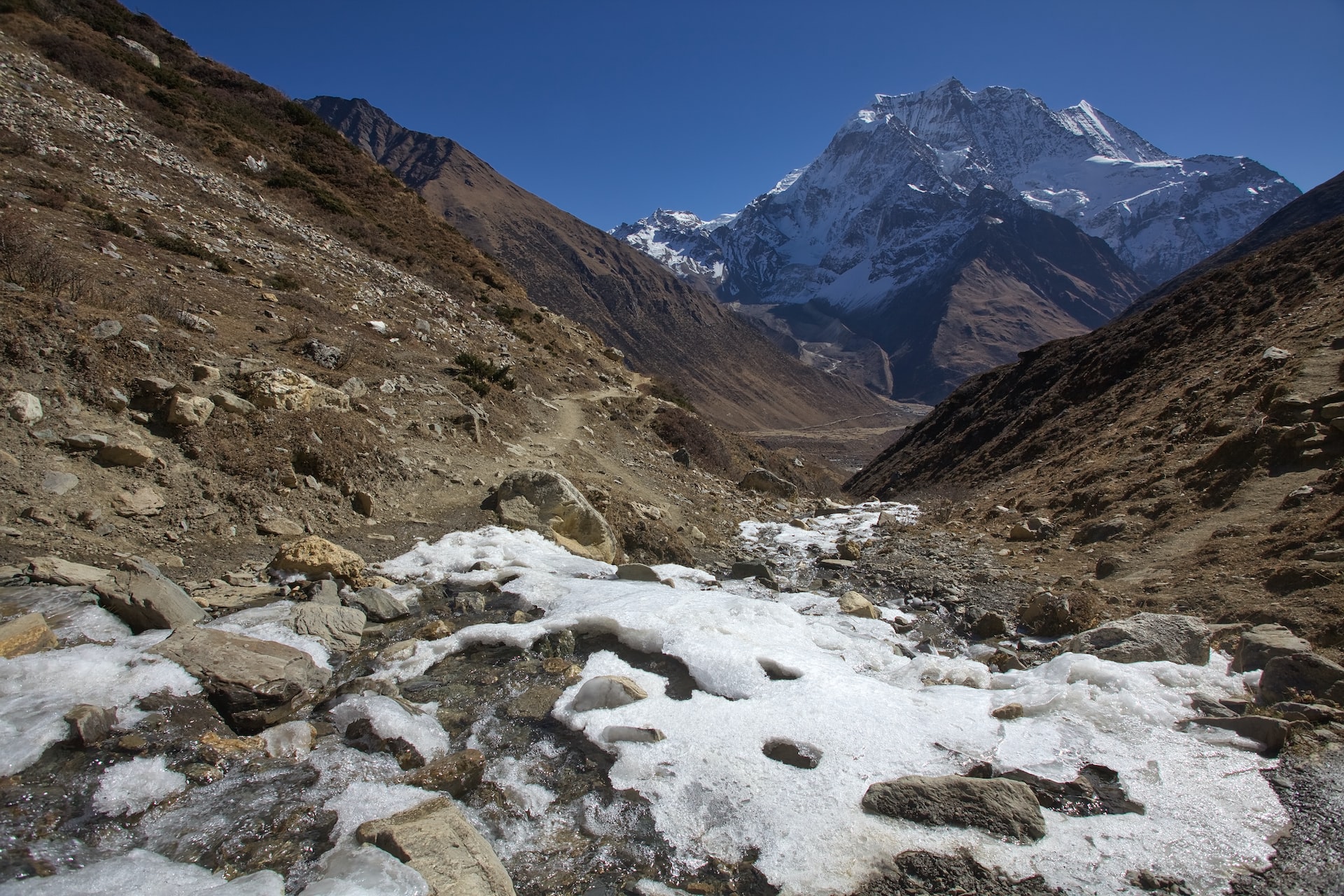
Manaslu Circuit Trekking is an adventure centered around majestic Mt. Manaslu, the eighth-highest summit in the world. Explore the Buddhist religion’s vast and fascinating culture amid the high Manaslu valley settlements. So, here in this article, we will discuss the Manaslu circuit cost and itinerary.
Trekking across cooler alpine highlands and towards the arctic zone of ice and glaciers from low, warm subtropical areas. From a beautiful forest of tall oaks, pines, birch, and rhododendron-magnolia trees to arid and desolate land Crossing the beautiful, high Larke-La pass, which offers the most spectacular view of the mountains and hills, approaching the Manang district along the Annapurna Circuit from inaccessible high Gorkha villages.”
The Manaslu Circuit Trekking with us is a thrilling and wonderful journey. Where you may take in the stunning view of high green hills, snowcapped peaks of the Manaslu Himalaya range, and cultural communities with fascinating customs.
Mount Manaslu
Mt. Manaslu was first scaled by a Japanese Expedition in 1956. Its elevation is 8,163 meters (26,781 feet), and its range of satellite peaks. That includes Bouddha, Sistine, and Himalchuli, among other smaller mountains. Manaslu Circuit Trekking was previously closed to outside visitors but has recently been reopened.
Since the areas were opened where few trekkers ventured, the Manaslu is now becoming more popular due to its remoteness and isolation from the outside modern world. The Manaslu is derived from the ancient Hindu Sanskrit word Manas, which means “the mind or soul of the god,” like the Holy Lake Manasarovar in Tibet close to Mt. Kailash.
Lines of fir and oak trees then move past Lo-Gaon to Sama-Gaon, the principal and the largest hamlet of the high Manaslu highlands, and into additional Tibetan-origin cultural villages that practice Buddhism. Sama-intriguing, Gaon’s colorful customs, and monastery can be explored after taking some time to rest and acclimate, after which you can continue with beautiful views of Manaslu. You arrive at Larke Phedi, the base of the Larke-la pass, in Dharamsala after trekking a series of peaks.
Why do Manaslu Circuit Trek
Because it takes place in a remote, mountainous area and involves hiking and camping in difficult terrain, the Manaslu Circuit Trek is regarded as an adventure. The journey traverses a range of landscapes, including forests, alpine meadows, and high-altitude passes, as it follows the Budhi Gandaki River.
Trekkers can explore the local Gurung and Tibetan-influenced villages’ culture and hospitality along the path. The journey also provides the opportunity to witness the wildlife, including the Danfe and the Himalayan Thar (a kind of mountain goat) (Himalayan pheasant). Additionally, the trek’s conclusion offers the chance to see the magnificent Manaslu mountain and its neighboring peaks.
Why is the Manaslu Circuit so popular?
Because it takes place in a remote, mountainous area and involves hiking and camping in difficult terrain, the Manaslu Circuit Trek is regarded as an adventure. The journey traverses various landscapes, including forests, alpine meadows, and high-altitude passes, as follows the Budhi Gandaki River. Trekkers can explore the local Gurung and Tibetan-influenced villages’ culture and hospitality along the path.
The journey also provides the opportunity to witness the wildlife, including the Danfe and the Himalayan Thar (a kind of mountain goat) (Himalayan pheasant). Additionally, the trek’s conclusion offers the chance to see the magnificent Manaslu mountain and its neighboring peaks. One of the main reasons is the suitable Manaslu cost and itinerary.
The chance to experience the culture and hospitality of the nearby Gurung and Tibetan-influenced communities is another factor in the popularity of the Manaslu Circuit Trek. Trekkers have the opportunity to mingle with the welcoming locals and discover more about their way of life. The trek also provides the opportunity to see traditional communities and visit historic monasteries.
Last but not least, the Manaslu Circuit trek is well-liked because it is regarded as a moderate to difficult trek, appropriate for anyone with some prior trekking or hiking experience. The trek offers a sense of achievement and adventure as well as the chance to push one’s physical and mental limits in a stunning and isolated environment.
Cost for Manaslu Circuit Trek
From December to August, a Manaslu trek permit costs USD 50.00 for the first 7 days and USD 7.00 for each additional day. Permit for the Manaslu Conservation Area (MCAP): Entry costs for SAARC nationals are 200 NPR per person and 2,000 NPR for other nationals. Moreover, if you travel with us then you will find a suitable Manaslu circuit cost and itinerary.
Detailed Itinerary for Manaslu Circuit Trek
Day 00: Arrival in International Airport Kathmandu Nepal 1,350 Mtrs 30 Min.
Welcome to the Himalayas and Nepal! Arriving at the airport, we meet you and drive you to your accommodation. We arrive at your accommodation to give you a Manaslu Circuit Trek briefing after you have rested for a few hours.
Day 01: Manaslu circuit trek preparation in Kathmandu.
Sightseeing in Kathmandu if you choose to can have an amazing experience, rest in your hotel, and prepare your equipment for the Manaslu Trek. Get sleeping bags and down jackets from a local supplier for the trek.
Day 02: Kathmandu-Dhading to Arughat Bazaar to Sotikhola 7-8 hrs by Drive.
Take an early morning drive from Kathmandu to Sotikhola, where the Manaslu Circuit Trek begins, today. Enjoy the journey through Arughat, a Gorkha hamlet, and the surrounding Nepalese landscape. Try your first excellent Dhaal Bhat at the lunch stop. Stay the night at Sotikhola, a riverside town on the Budhi Gandaki.
Day 03: Sotikhola-Labubensi-Khanebensi to Machhakhola 869 mtrs 5-6 hrs..
Trek through shady sal forests today on the Manaslu, and you might see some Gray Langur monkeys. As we travel through the Budhi Gandaki waterway, we frequently have to pause to allow trains of loaded mules to pass as they move goods between settlements.
Never forget to move to the “mountainside” to allow them to pass on little trails. We finally reach the sizable Gurung settlement of Macchakhola, where numerous hikers were rescued during the earthquake on April 25, 2015, after going via the village of Khanibensi.
Day 04: Machha Khola-Khorla Bensi-Tatopani and Dovan to Jagat 1,400mtrs 7-8 hrs.
In Machhakhola, the day begins with a crossing of the Fish River close to the mule loading area. The route follows the Budhi Gandaki to Khorlabesi, 960 meters above the level, where espresso coffee beans are grown, and then to Tatopani, 930 meters above sea level, where a hot spring bubbles forth from beneath a sheer bluff.
It then continues on the eastern bank of the Budhi Gandaki to Dovan 1,070 mtrs where we pause for lunch, then Thulo Dunga, and Yara Bagar 1,370 meters. Additionally, this route is suitable for most people as this itinerary is very suitable and affordable providing the best Manaslu circuit cost and itinerary.
The Gurung religious place of Jagat, with its wonderful flagstoned village square, serves as the entry gateway to the Manaslu Conservation Area.
The trail then traverses the Budhi Gandaki back and forth on suspension bridges. Here, restricted area licenses are examined in a conservation area office. As a result of its proximity to the Tibetan border, prayer flags, stupas, and mani walls can all be seen as Tibetan Buddhist influences.
Day 05: Jagat-Sirdibas-Philim-Ekle Bhatti-Nyak to Deng 1,750 mtrs 6-7 hrs.
The trail ascends to Salleri and Sirdibas, where many homes were devastated in the earthquake, after leaving Jagat. Following Ghatta Khola, we traverse one of the circuit’s longest suspension bridges over the Budhi Gandaki River.
The terrain grows increasingly parched as we make our way to Philim for lunch after a strenuous ascent. We arrive at Ekle Bhatti, where the exit for Lokpa and the Tsum Valley is located, after lunch. Before arriving at Pewa and then Deng, go through lovely pine forests near the junction of the Budhi Gandaki and Shar Khola rivers.
Day 06: Deng-Rana-Bihi Phedi to Namrung 2,660 mtrs 5-6 hrs.
Several communities that have been rebuilt since the earthquake are now located along the path. The Prok Village is on a plateau and provides a view of Sringi Himal. where we make our way through on our walk. We stroll through a stunning forest, past fir trees, azaleas, Pieris, rosehips, songbirds, and langur monkeys, before descending from Prok to Ghap.
Finally, we reached Namrung, which used to be a customs station along the salt route to Tibet. The regional spoken dialects exhibit Tibetan influences. One may see Sringi Himal and Ganesh Himal. Both of which are 7,140 meters high, from Namrung in a distinct light.
Day 07: Ghap – Namrung – Lihi to Lho 3,180 mtrs 3-4 hrs.
Despite it being a simpler day, the environment is still breathtaking. We will visit the settlement of Lihi after passing over the lovely Bhanzam plateau, which is dotted with stone homes and fields of barley. After eating here, we cross the Hinang River and arrive in Lho, where the Ribung Gompa is the most prominent structure.
Day 08: Lho-Syala to Samagaun 3,525 mtrs 3-4 hrs.
You enter the highlands on this day, giving you time to see the breathtaking vistas and adjust to the altitude. Visit the Ribung Gompa to begin the climb before continuing up a gully of pine and rhododendron to Syala 3,510 meters. Where we stop for tea and get our first breathtaking view of Mt. Manaslu, 8,163 meters, before continuing.
Enjoy the 360-degree views that the plateau’s deforestation has provided from this location. We eventually arrive in the settlement of Samaguan. After continuing our hike through a landscape filled with yaks, pastures, and stone cottages and traversing the slope draining the Pung Gyen glacier. This town is the biggest and nearest to Manaslu Base Camp on the Manaslu circuit.
The trail to Manaslu Base Camp begins at Birendra Tal. A glacial lake at the foot of the Manaslu glacier, which we climb to shortly after lunch.
Day 09: Rest Day in Samagaun 3525mtrs for acclimatization
You can wash your clothes, read your book, and take a warm shower on this day of complete rest. Additionally, it is advised that you do a 6-7-hour acclimatization climb to Pung Gyan Gompa or Manaslu Base Camp (9-10 hrs). Moreover, this itinerary provides the best Manaslu Circuit Cost and itinerary. Watch out for Himalayan Tahr on the sheer rock faces when hiking.
Explore Samaguan village as well to get a feel for the community’s culture. View the numerous mani walls, which are constructed from countless mani stones. That has been etched with Buddhist symbols and writings.
Day 10: Samagaun to Samdo 3875 Mtrs 3-4 hrs.
Due to the high height, today’s walk is short but has spectacular mountain scenery. The trail runs north through juniper and birch trees before becoming more difficult as we begin the yak trails. A large valley with long mani partitions and several marmots keeping guard from their burrows. Relaxing in the afternoon sun is what we travel through.
We arrive at Samdo village after passing the Buddhi Gandaki River’s source. Under the Samdo Himal, which is 6,335 meters high, and the Samdo Glacier sits the Tibetan refugee village of Samdo. The Lajyang La Pass, which rises the right-hand valley from a height of 5,098 meters, is the main route into Tibet. Ahead and to the left is the Larkye pass.
Day 11: Samdo-Larkye Bazaar to Dharamsala 4,460 Mtrs 3-4 hrs.
Start your journey slightly upward to the legendary Larkya Bazaar. From there, turn right to reach Tibet via the bustling markets at Lajyang Bhanjyang (5,375 m) and Gyala Bhanjyang (4,998 m). The trail begins to ascent to the pass as the sizable Larkye glacier flowing from Mt. Manaslu can be seen on the left. We go along the Larke Khola after crossing the Athhara Saya Khola.
You might see some Bharal or Himalayan Blue Sheep grazing on the slopes along the way. The secretive Snow Leopard, which resides in the higher alpine regions, mostly hunts them. We finally arrive at Dharamsala’s mountain amenities after continuing our ascent higher.
Day 12: Dharamsala – Larkye Pass 5,160 mtrs to Bimthang 3,590 mtrs 7-8 hrs.
We get up at three in the morning, have breakfast, and then climb a little distance to get to a valley with stunning views of Larkya Peak on the north side of the Larkya glacier. Moreover, we climb the enormous glacier’s lateral moraine, which gets rather steep just before we get to the pass.
We can get to the pass before the brisk, chilly morning winds by breaking camp early. We get breathtaking views of the Himlung Himal (7,126 meters), Kang Guru (6,981 meters), the Annapurna II range (7,937 meters), and other peaks from the summit of the pass. Moreover, this itinerary provides the best Manaslu Circuit Cost and itinerary.
The initial portion of the descent is fairly steep, and using crampons during the winter seasons may be necessary. After many hours, the trail levels off and descends 1,400 meters over three to four hours. It concludes at the breathtaking Bhimtang, where the breathtaking panorama of Manaslu justifies every step.
Day 13: Bhimthang – Yak Kharka-Karche-Gho to Tilije 2,300 mtrs 6-7 hrs.
The trip begins after a sound night’s sleep and a filling breakfast, and after 25 meters, we pass the Kechakyu Khola glacier and enter the Rhododendron-wooded area. You can witness the stunning display of Rhododendron blooms in full bloom if you visit during March or April.
Mt. Manaslu may be seen from an equally magnificent view. Eventually, the trail ascends to the Gurung settlement of Gho and continues to Tilije, where there are better lodging options.
Day 14: Tilije – Dharapani – to Besisahar 760 Mtrs 5-6 hrs.
Take a stone path out of the community and quickly descend to the Marsyangdi Valley in Thonje. In Dharapani, 3,560 meters away, you will then join the new road that runs alongside the major Annapurna Circuit route. Moreover, this itinerary provides the best Manaslu Circuit Cost and itinerary. You will take a public jeep from this location to Besisahar, where you will spend the night in a motel.
Day 15: Besisahar to Kathmandu
The district office for the Lamjung district is located at Besisahar. From this location, you can take a private vehicle or a public bus to Kathmandu. The route then follows the Marshyangdi River. Past many Gurung, Magar, and other villages before arriving at Dumre Bazaar. Then proceed to the capital while rafting the Trishuli River along the Himalayas. After finishing the Manaslu Circuit Trek, one will be in comfortable accommodation for a good night’s sleep.

